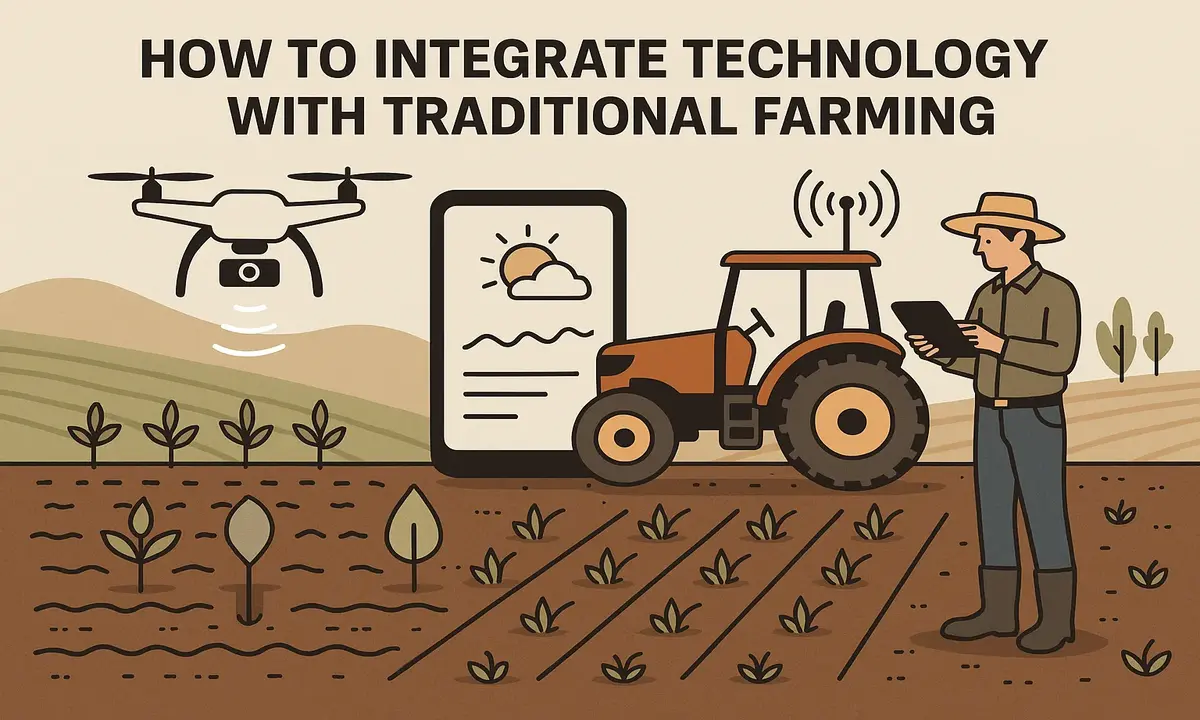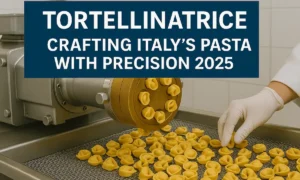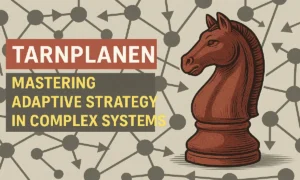Farming has always thrived on tradition, instinct, and generations of wisdom. But today’s global food challenges call for a smarter approach. That’s where technology steps in—not to erase tradition but to enhance it.
In this blog, we’ll dive deep into how to integrate technology with traditional farming, exploring practical tools, real-life examples, step-by-step strategies, and a futuristic outlook on what’s possible. By the end, you’ll know how to:
- Improve productivity without abandoning your roots
- Use modern tools like drones, sensors, and apps
- Overcome challenges like cost, internet access, or resistance to change
Let’s explore how heritage and high-tech can grow together.
What Is Traditional Farming?
Traditional farming is rooted in cultural heritage, often relying on techniques passed down through generations. It’s a system where sustainability, community, and harmony with nature take center stage.
Traditional farming is more than old-school methods. It’s an ecosystem of values, practices, and relationships with nature. Characteristics include:
- Manual labor and animal-driven tools
- Seasonal planting guided by lunar cycles
- Composting and organic manure use
- Natural pest control and seed saving
- Indigenous knowledge passed down through generations
While these methods are sustainable and deeply rooted in culture, they struggle with scalability, efficiency, and climate resilience. Integrating tech bridges this gap without compromising the heart of tradition.
These farming techniques are often region-specific, reflecting the biodiversity and climate of their areas.
They’re typically passed down through generations by observation and experience. While not always written down, this wisdom holds valuable insights into soil care, pest resistance, and crop cycles.
Why Technology Belongs in Farming
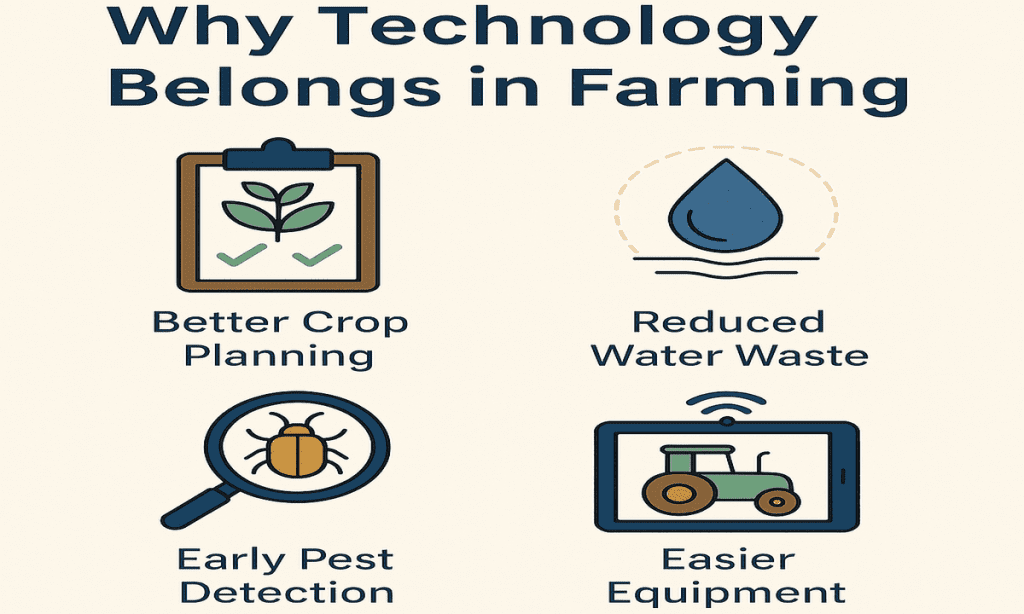
Technology has become essential for farming in the 21st century. It solves modern agricultural challenges by increasing precision, efficiency, and profitability while protecting the environment.
Technology isn’t just a trend—it’s a necessity for modern farming. Here’s why:
- Precision: Reduce waste with accurate planting, watering, and fertilizing
- Data-Driven Decisions: Make informed choices based on real-time data
- Efficiency: Save time with automation and smart scheduling
- Sustainability: Use fewer resources, protect the environment
- Profitability: Boost yields and connect directly with markets
Rather than replacing age-old practices, tech provides a toolkit for strengthening them.
With climate unpredictability and population growth, farmers need new tools to ensure food security. Technology allows farmers to scale their operations and adapt more swiftly. It helps protect the environment while increasing yield potential.
Read More: Unlocking the Power of IT: Revo Technologies in Murray, Utah
Exploring Essential Farming Technologies
There are many modern tools that farmers can adopt to improve operations. From soil sensors to satellite imagery, each plays a specific role in advancing traditional practices.
Drones: A Bird’s Eye on Your Crops
Drones can scan large fields in minutes. Benefits include:
- Detecting irrigation issues
- Spotting pest infestations early
- Creating crop health maps
- Spraying inputs with precision
They help in diagnosing problems before they become disasters.
Soil Health Sensors
Insert small sensors into your field to monitor:
- pH levels
- Soil moisture
- Nutrient deficiencies
This allows you to customize your input usage, reduce runoff, and promote soil longevity.
Weather Monitoring Tools
Install on-site weather stations or use satellite-based apps to:
- Predict rain or frost
- Adjust planting and harvesting schedules
- Minimize damage from extreme weather
Forecasting helps avoid crop losses and optimize timing.
GPS & GIS Technology
These systems allow:
- Site-specific planting and fertilizing
- Mapping of soil types and problem areas
- Reduced overlap and wastage in fieldwork
Precision agriculture is the new face of sustainability.
Automated Irrigation
Smart irrigation systems connect to weather and soil data, helping you:
- Irrigate only when needed
- Save water and energy
- Maintain consistent soil moisture for better crop growth
Mobile Apps for Farm Management
Track every detail of your operation:
- FarmLogs and AgriApp: Record inputs, predict yields
- Kisan Suvidha: Weather updates, mandi prices
- IFFCO Kisan: Expert advice and agri-market news
Apps reduce paperwork and improve planning.
Steps to Combine Tradition and Technology
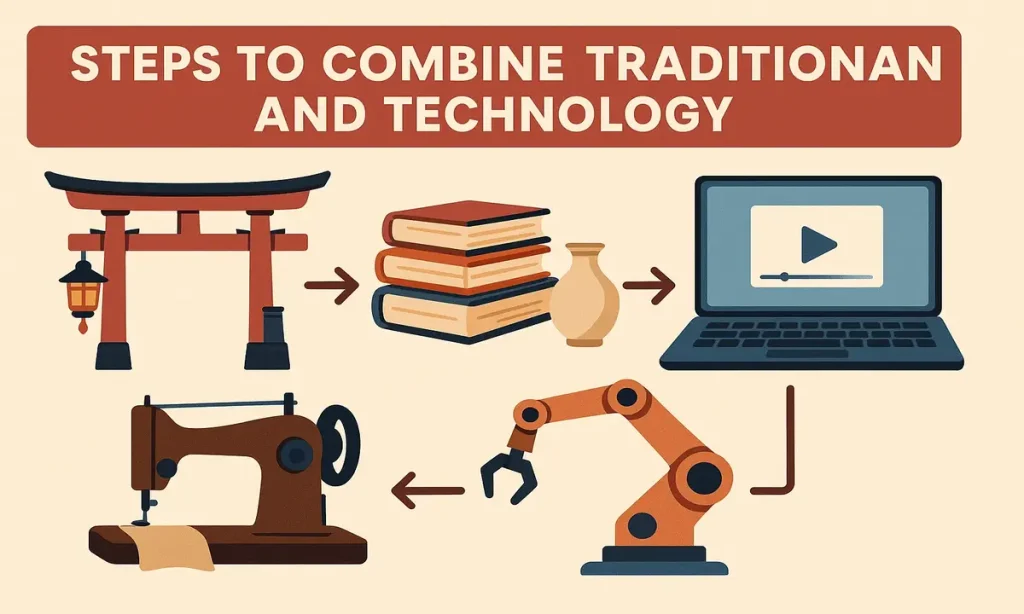
Merging tech with tradition doesn’t happen overnight. Follow a step-by-step process that allows you to assess needs, adopt solutions gradually, and ensure compatibility with traditional methods.
Step 1: Assess Your Farm’s Needs
Look at pain points:
- Is labor getting harder to find?
- Are pests or weeds affecting yield?
- Are you struggling with unpredictable weather?
Understanding your challenge will help you choose the right tech.
Evaluating your farm helps prevent unnecessary investments. It also encourages you to address the most pressing concerns first. Tailoring solutions to your specific context makes adoption smoother and more effective.
Step 2: Start with Low-Risk Solutions
Ease into tech adoption:
- Start with weather apps or irrigation timers
- Introduce low-cost sensors before drones
- Use mobile tools before big machines
This phased approach builds confidence.
Beginning with simple tools ensures you’re not overwhelmed. These initial wins can help build trust in technology. It also allows older generations to see the value firsthand.
Step 3: Combine Old and New Methods
Respect traditional systems by enhancing them:
- Pair organic composting with soil test reports
- Continue manual weeding, but monitor weed spread with aerial images
- Use natural pesticides, informed by digital pest forecasts
A hybrid model ensures resilience and relevance.
Maintaining a cultural connection is important. By improving rather than replacing traditional practices, tech can gain acceptance. Innovation then becomes a shared effort rooted in tradition.
Step 4: Learn, Train, Collaborate
Knowledge is power:
- Join webinars and demo days
- Connect with agri-tech platforms or NGOs
- Ask younger family members for help with digital tools
A shared learning journey makes adoption smoother.
Farming communities thrive on shared wisdom. Collaboration ensures the knowledge transfer isn’t one-way. This creates a support network for ongoing tech use and evolution.
Also Visit: Fre24onlinne: The Ultimate Platform for Tech, Travel, and Shopping
Case Studies: How Farmers Worldwide Are Succeeding
Farmers across the world are already seeing benefits from using tech. Their stories offer valuable insight into how digital tools can be successfully adopted while preserving core values.
Pedro from Brazil
Pedro farms soybeans and corn. He installed IoT sensors and adopted satellite-based planting maps. His results:
- Reduced fertilizer use by 35%
- Increased yield by 20%
Pedro started small and gradually scaled his tech use. He found that real-time data gave him more control. His success inspired other nearby farmers to try similar tools.
Amina in Kenya
Amina sells vegetables in local markets. By using mobile market apps and digital wallets:
- She eliminated middlemen
- Earned 40% more per harvest
- Built direct customer relationships
Access to pricing and customer data helped Amina grow her business. She also joined a co-op that trains others in digital sales. This empowered more women in her community.
Tanaka in Japan
Tanaka uses robots to weed his rice paddies. Though traditional in layout, his farm is:
- 100% organic
- 30% more efficient than before
Tanaka respects his ancestors’ farming methods but improves them with precision tools. His story shows that technology and heritage can thrive together.
Benefits of Blending Tech with Tradition
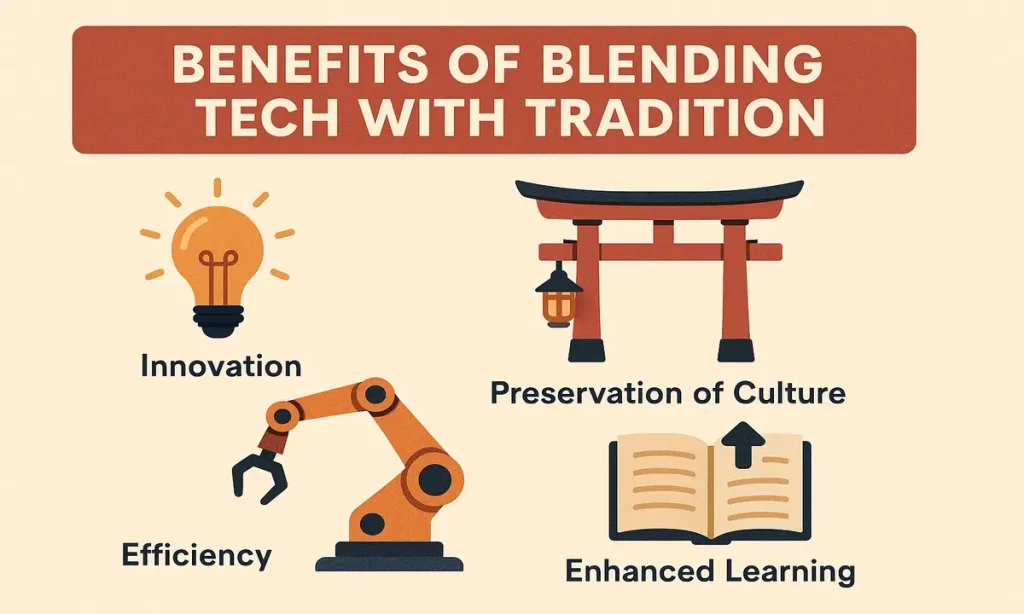
Combining new tools with time-tested methods results in smarter, more resilient farming. It offers environmental, economic, and operational advantages that are hard to ignore.
- Smarter Decisions: Real-time insights mean better planning
- Eco-Friendly: Less water, fewer chemicals
- Trackable Data: Keep better records, forecast profits
- Resilient Systems: Tech helps adapt to climate shifts
- Better Market Access: Sell smarter, not harder
When done right, the combination leads to sustainable, profitable farming.
Blended farming improves both productivity and sustainability. It builds on existing strengths while solving emerging problems. The result is a future-ready, community-centered approach to agriculture.
Common Hurdles and How to Overcome Them
Adopting new technologies can bring up concerns and barriers. Addressing these fears with practical solutions can ease the transition for traditional farmers.
“Tech is too expensive!”
- Solution: Start small. Use free tools. Try shared or rental models.
- Explore subsidies and rural tech programs.
Community-led sharing models lower individual costs. Renting machinery or accessing co-op tools reduces risk. Awareness of government programs also opens up opportunities.
“I don’t understand the technology.”
- Solution: Watch videos. Join WhatsApp farming groups.
- Pair up with someone who’s tech-savvy.
Tech learning doesn’t require formal education. Many resources are visual and local-language friendly. Youth involvement often helps bridge the generational gap.
“There’s no network in my area.”
- Solution: Many tools work offline or with SMS.
- Download data when you’re in town.
Offline-compatible tools are growing in popularity. Even remote farms can collect useful insights. Planning ahead with downloads makes a big difference.
“I fear losing traditional methods.”
- Solution: Tech is a support system, not a replacement.
- Keep your rituals and values—just add smart tools to support them.
Cultural identity in farming should be preserved. Tech complements, not competes with, heritage. This mindset makes the transition smoother and more respectful.
Future of Tech in Farming
The next wave of farming will be driven by advanced technologies like AI, robotics, and blockchain. Staying informed helps farmers prepare and adapt to the future landscape.
What’s next on the horizon?
- AI-Powered Forecasts: Analyze patterns, suggest best planting windows
- Agri-Robots: Automate weeding, harvesting
- Hyperlocal Satellite Data: Zoom in on your specific plot
- Blockchain for Food Traceability: Track farm-to-fork transparency
Being future-ready ensures your farm stays competitive and productive.
Tech is moving toward personalization and hyper-local solutions. Future tools will cater to individual plots, not just regions. Keeping up with these trends is key to long-term success.
Conclusion: Merging Roots and Revolutions
You don’t have to abandon your grandfather’s methods—just enhance them. By blending ancient wisdom with modern tools, your farm can become more productive, resilient, and sustainable.
You don’t need to abandon your grandfather’s ways. Just strengthen them with your own upgrades. A farm that blends ancient wisdom with new-age tech is not only more productive—it’s more resilient, profitable, and sustainable.
The world needs farmers like you—grounded in tradition, open to innovation.
Let your land tell its story—with sensors, apps, data, and heart.
Frequently Asked Questions:
What if I try tech, and it doesn’t work for me?
Start small and experiment. Not every tool fits every farm, but trial and error leads to the right match. Keep an open mind and adjust based on what works best for your setup.
Will using tech harm the environment?
Quite the opposite. Most agricultural technologies aim to reduce waste, lower chemical use, and preserve resources like water and soil health. When used properly, tech supports eco-friendly farming.
How do I convince older generations to accept farm tech?
Start by showing results—like better yields or easier workflows. Use simple tools first and let them experience the benefits firsthand. Respect their experience while introducing small changes.
Are there risks with using digital tools?
As with any tool, there can be risks like data loss or device failure. Minimize these by backing up data, updating tools, and choosing trusted providers. Community support can also help troubleshoot issues.
Can tech really help me make more money?
Yes. Tech boosts efficiency, reduces losses, and opens access to better markets. Whether it’s through mobile sales platforms or smarter irrigation, small investments can lead to big returns.
